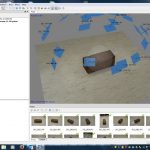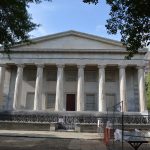Lots of talk in academia about the use of technology and computers but unfortunately it seems that much of it revolves around blogs or other social media platforms. However, that doesn't always cut it in the field of historic preservation. Documentation is a key component in the field and one that is well suited to take advantage of technological changes and while we have been progressive in some respects we are now adding some additional digital documentation tool sets to our toolbox. While not new to other preservation programs Agisoft Photoscan software, SketchFAB (online 3-D viewer, free), and Unity (animation software, free) all offer some pretty cool possibilities and come with a small price tag (in some cases free). Below is a model made in Agisoft Photoscan and then placed within SketchFAB (an online viewer). Brick on Sketchfab … [Read more...]
Sometimes its the Little Things
During the fall my HISP 461 Building Forensics class descends on a local historic building in hopes of providing the owner or organization with additional information. While we dig through local archives its often the observations concerning the physical fabric of the building which offer the most additional insight about the buildings development over time. This fall the class is investigating the Masons Lodge at the corner of Princess Anne Street and Hanover Street in Fredericksburg. Fortunately for us, the original building specifications survive in the Lodge's records and date the building to c. 1816. The specifications also allow us to compare the current physical fabric with what is noted in 1816 helping to discern what is original (period 1) and what has been added or changed over time. For instance the original specifications note "...the large room to be finished in a plain stile [style] with chair board of only plain plank 4 inches wide with a bead on each side..." With a … [Read more...]
Year in Review, 2016
As the spring 2016 semester comes to a close, the UMW Center for Historic Preservation is excited to congratulate our newest historic preservation graduates. We are also happy to celebrate the end of a successful academic year and a busy year for the Center. For those wondering what the Center for Historic Preservation does to help facilitate our mission of preservation education and community outreach, below are some of the 2015-2016 highlights: • Sponsored and facilitated 5 lectures ranging from laser scanning to economics in historic preservation. • Extensive involvement in four external grants including a historic structures inventory and integrity assessment for the Blue Ridge Parkway ($13,670), a moisture ingress investigation and treatment plan for the Second Bank of the United States ($73,995), a Duff McDuff Green Jr. grant for architectural drawing conservation at UMW ($6,250), and recently a grant secured by Dr. Lauren McMillan from the Council of Virginia … [Read more...]
A Closer Look at the Goodwin House
A Closer Look at the Goodwin House: The North Wing of the Mary Washington House Michael G. Spencer While the south wing of the Mary Washington House, the portion in which Mary lived, has received quite a bit of attention over the years, the Goodwin or north wing of the building has remained shrouded in mystery. However, as students in HISP 461 have looked into the history and begun to examine the materials of the building it has become increasingly apparent that the building is a contemporary of the south wing or Mary’s House and likely dates to the 1760s. Both the south wing and the Goodwin House were likely constructed by Michael Robinson between 1761 and 1771. The first concrete mention of a building, of which I am aware (aside from standard deed/legal language which can often be misleading) is a reference made in one of George Washington's letters noting that his mother Mary has picked a “commodious house, garden and lotts” in Fredericksburg in which to reside (“From George … [Read more...]
Center for Historic Preservation Examines Moisture Problems at the Second Bank of the United States
The Center for Historic Preservation received $73,995 in funding over the summer to study ongoing moisture problems at the Second Bank of the United States in Philadelphia, PA. Designed by William Strickland in 1819 and completed in 1824, the bank illustrates well the Greek Revival style. Today the bank is home to a large Charles Wilson Peale collection. … [Read more...]
Fall 2014 Newsletter
UMW's Historic Preservation Newsletter for Fall 2014 is available below! In this issue we congratulate the recent graduates, give updates on campus buildings, alumni, Stratford Hall Plantation field school, and the HISP club. There are also a few entries from current students sharing stories from their summer internships. If you would like to receive a digital copy please fill out this form so that you can be added to the email list! Enjoy and be on the look out for the Spring Newsletter! Fall 2014 Newsletter 10.30.14 … [Read more...]
Stafford will study slavery locations
University of Mary Washington Historic Preservation professor Douglas Sanford will spearhead an effort to study slavery locations in Stafford County, Virginia. This work will be conducted with support from the University of Mary Washington Center for Historic Preservation as well as funds from Stafford County which were obtained as part of a Virginia Department of Historic Resources grant. Follow the link to learn more (http://news.fredericksburg.com/newsdesk/2014/07/31/stafford-to-study-slavery-locations/) … [Read more...]
Historic Buildings of Fredericksburg Website
The Historic Preservation Planning Laboratory of Spring 2010 designed and implemented a website! The Historic Buildings of Fredericksburg database was created in order to provide a central depository of information about buildings in Fredericksburg that had previously been scattered, and make it available to the public at large. The database was created for the Center for Historic Preservation at the University of Mary Washington in the Spring of 2010 by a preservation planning course taught by Smith. The grunt work was done by the students: Chelsea Corcoran, Bill Pieper, Sarah Moore, Megan Hall, Bridget Travers, and Helen Dinndorf. Please check it out, and enjoy! … [Read more...]





